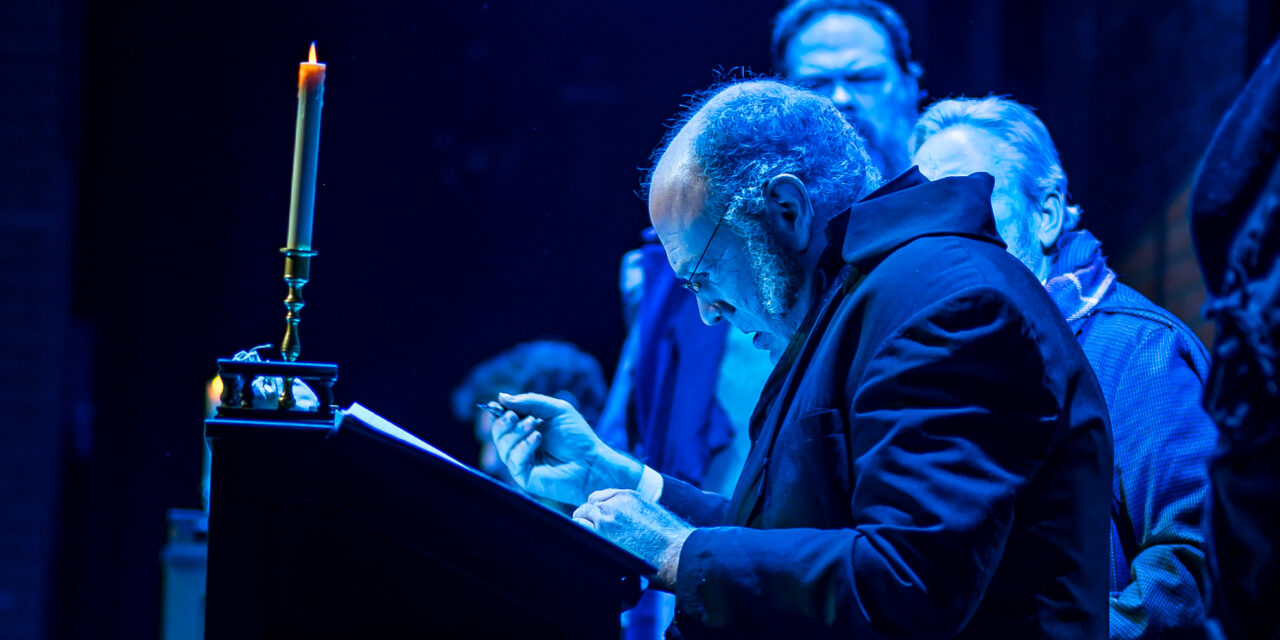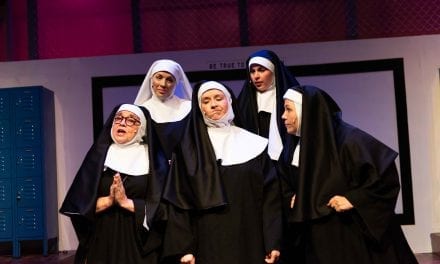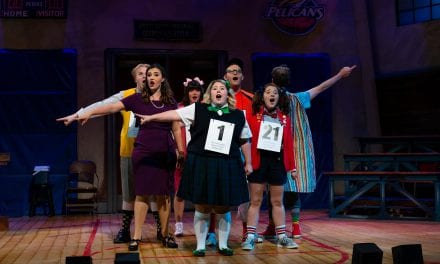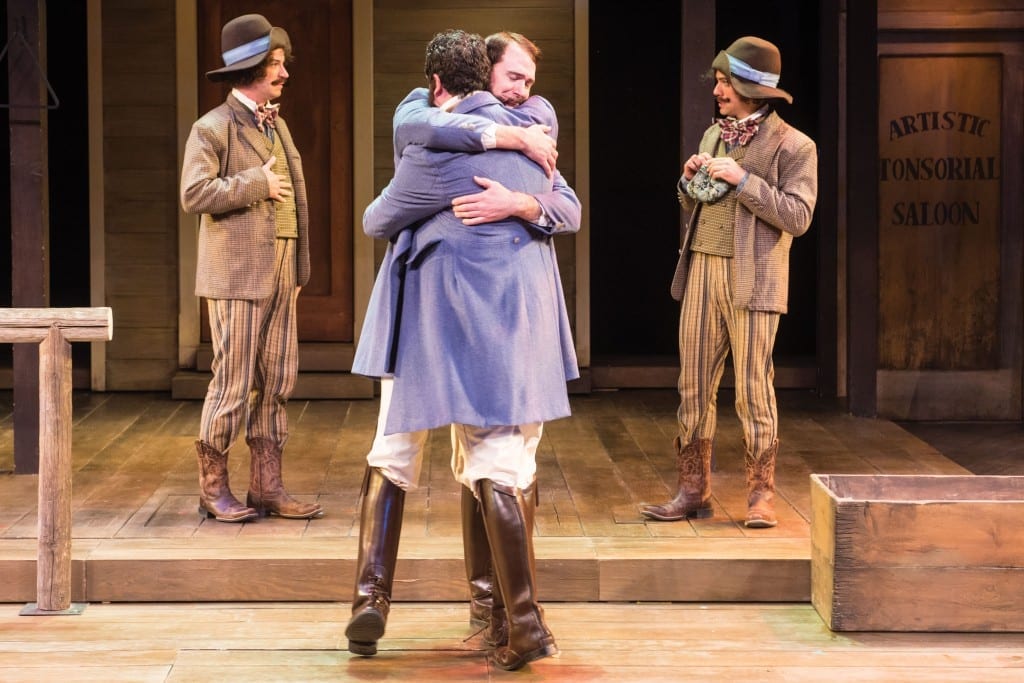SOUTH SALT LAKE — Charles Dickens’s A Christmas Carol is adapted for the Parker Theatre stage in a returning holiday engagement. Directed by Spencer Hohl, the production is a haunting delight in delivering a story iconic to the Christmas season. This rendition leans into supernatural horror and ghostliness as Ebenezer Scrooge is visited by the Ghosts of Christmas Past, Present, and Future. There was a weighty sense of consequence for Scrooge to remain unchanged by these visitations. In fact, by leaning into this Christmas Ghost story, I recognized the story’s haunting caution: how effortlessly Scrooge found himself cold, heartless, ignorant to others, and acting in his own self-interest. Gratefully, for Ebenezer Scrooge and all of us, a generous change of heart is possible. The production is wonderfully moving and delivers a message with meaning.
I was most impressed by the sound design of the production by Director Spencer Hohl. Selections of instrumental music, particularly familiar Christmas carols, playing over scenes added to the performance’s depth and ambiance. Christmas music has a powerful joyful effect, which creates a stark contrast when the instrumental isn’t present. The offices of Scrooge and Marley are dull and stiff, neglected from joy, as is the home of Scrooge. Silence in this production has an impressive effect and greatly communicates the consequences of Scrooge’s past actions. Additional sound effects aided in this communication and created a rich experience. The haunting sounds of clanging chains, shocking lighting, and thunder contrast well with the sounds of bells and laughter in invoking emotions during memories and visions.
Throughout the production, the projections and lighting design by James B. Parker are equally effective in supporting the ambiance. Scrooge’s offices and his home are dim and harshly lit – devoid of light. Even the window’s shadows in the home look like a tight square cage casting down on Scrooge. However, the lighting in Cratchit’s, Fred’s, and Fezziwig’s homes is bright and the window’s shadows have an openness in shape and style. When Christmas Future appears to show Scrooge visions of the future with its bleakness, the stage is densely dark and shadowed. The lighting, projections, and sound are tremendously effective in showing both Scrooge and the audience the future. When morning breaks with bright light in the next scene, Scrooge awakes in a rebirth of energy and soul.
Brinton M. Wilkins is a marvelous Ebenezer Scrooge, transforming the character from deeply unlikeable to genuinely jovial and generous. Wilkins’s initial scenes set up a deeply haunting character in Scrooge’s heartlessness and disdain. Watching Wilkins’s biting, harsh delivery to those interacting with the pre-transformation Scrooge is difficult. These early scenes clearly establish Ebenezer as ignorant of other’s needs (including his own) and unapologetic for his stance toward the poor and homeless. Following each Christmas Spirit visit, Wilkins’s begrudging admittance of flaws leads to real sorrow and meaningful reflection.
Wilkins’s transformation of Scrooge is outstandingly meaningful. When Scrooge wakes on Christmas morning, Wilkins’s demeanor is full of relief and pleasantness. Wilkins has this great comedic bit of struggling to dress due to exuberance during this scene which reminded me of a child’s excitement on Christmas morning. It is absolutely infectious and an ultimately convincing prelude to show Scrooge’s total change of heart for the rest of the story.
Matthew Delafuente plays the younger Ebenezer appearing in memories of Christmas Past. Delafuente portrays the young Eben with diligence to his master Fezziwig and still holding on to the joy of humanity. This is particularly clear in the scene showing the newly budding relationship between Ebenezer and Belle, played by Isabelle Purdie. Purdie and Delafuente have a brief meeting and dance to convey the love felt between their characters and it works. Belle is dressed in gold in this dance, alluding to how Scrooge’s initial treasured love will be replaced. When Belle breaks off her engagement to Ebenezer, Wilkins’s reaction as older Scrooge to young Scrooge failing to follow her is heartbreaking. Delafuente simply steps away from the closed door and returns to work, choosing to pass on the treasure of love. The sum of Scrooge’s choices is clear in the contrast between the reactive performances of the older and younger men.
Parker’s adaptation of A Christmas Carol begins before Marley dies. Stephen Harmon plays Jacob Marley in this brief opening scene and the character is immediately distasteful to watch. Later when Marley appears as a ghost, Harmon delivers a harsh, intense, and raw performance that sets up the stakes if Scrooge fails to change. It is truly haunting, but unfortunately, Harmon’s mic cut out several times during the scene so some lines were lost underneath the background sound.
Marley is easily different from Bob Cratchit, played by Lucas Charon, and nephew Fred, played by Tanner Tate. Where Scrooge fits in with Marley, he is at odds with the demeanor of Bob Cratchit and Fred, both in the holiday spirit. Charon in this scene and later in the visions of Christmas Present and Future is great at showing joy despite long-suffering circumstances. Charon does well to embody the father figure and gives an endearing performance. Tate likewise embodies joy and graciousness so absent from Scrooge. It is very moving to watch Fred genuinely seek his uncle’s attendance for Christmas, and then joy when Scrooge shows change by arriving at Fred’s party.
The production uses several child actors who each play multiple roles. These young performers add to the story with simple performances. Each child role, like Tiny Tim played by Charlie Harris, is needed to tell the story effectively, and each child actor plays well with the others. As a live performance, I even found it pleasant to notice moments when the adult performers supported the children and interacted with them onstage.
A Christmas Carol at the Parker Theatre is a great addition to the Christmas season and a wonderful reminder of our shared humanity and need for generosity. The production uses performances and design to deliver a moving and emotional story of transformation. I greatly appreciated how the choices in the adaptation built the story and kept the momentum growing through to the finale. The show is an excellent addition to celebrate the holiday season.

These reviews are made possible by a grant from the Salt Lake County Zoo, Arts, and Parks program.





